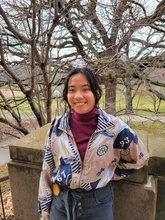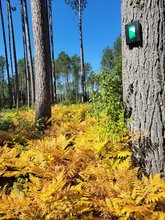
Junior, B.S. Forest and Natural Resource Management
Bianca Sophia Vargas is a junior studying Forest and Natural Resource Management (B.S.) at the University of Minnesota. She immigrated to Lakeville, MN when she was 9 from the Philippines. She doesn’t remember much about it, other than being really into learning English, despite not knowing at the time she would later move to the U.S.
“Growing up, I didn’t really know that I wanted to be working with the environment. I was really pushed toward being a nurse, and I did not want to be a nurse, so I took a really indirect route to where I am now.”
After high school, Bianca headed off to Knox College in Illinois to study computer science, but she quickly learned that was not for her. “I didn’t like sitting down.” She found that being a woman in a STEM field was (and still is) challenging but soon found inspiration in a class on environmental racism. Knox didn’t have a program that fit, so she transferred across the country to the University of San Francisco to study Environmental Science. And then, of course, COVID-19 hit and changed everything. Bianca took a semester off and came back home to Minnesota to think about her future. In the process, she joined the Conservation Corps—an environmental youth service organization in St. Paul, MN. It was a good opportunity to get outside, make some like-minded friends, and get her hands dirty.
She became a crew leader in the Corps, and her groups consisted of young adults as children weren’t allowed during the start of the pandemic. When the kids returned in the summer of 2021, it was obvious they had been affected. “The pandemic took a really big mental toll on everyone, and the kids were really feeling it.” Some of the kids were away from home for the first time. Some were expecting a summer camp and were somewhat shocked to find a summer camp focused on work and service instead of knots and sailboats.
“Last summer we got to do a lot of cross-cutting. I had not done that before, but I did have chainsaw skills. It was super fun. It was really easy. When I tell people that I’ve cut big cedars—I actually have tree cookies in my car—and I have all this sawing experience and do difficult work, they get surprised, especially because I’m like 5 feet tall.”

She decided to stay home in Minnesota and transferred to the University of Minnesota where she started in the Environmental Science, Policy, and Management program before switching to the Forest and Natural Resource Management degree to pursue work with forest fires. “I don’t fit the stereotype of a forester—let alone one who wants to work with fire. When I tell people that I’m a forestry major, I tell them that I look at trees and walk around all day, but it’s obviously more complex than that.”
She says it can feel a little weird sometimes being one of a few women in a class, as people naturally tend to clump up with their own gender just like they do as children. Forestry as a profession lacks visibility. We rarely see it in action in our daily lives, despite living in such close proximity to trees. When we think of a forester, we often think of the iconic Minnesota folk heroes Paul Bunyan and Babe his Blue Ox because so few people have a real person to consider for reference.
“It’s a small niche of people that do forestry work, so when you ask them what they do for a living, they talk your ears out about it. I like that about the community. We can just point to trees and quiz each other for Dendrology. I like how small it is. I get to learn more about the people I’m with. It’s a small community, but the small ones are usually more tightly knit.” Finally, she has found a good fit.

The Forest Scene newsletter is published biannually in the spring and fall, featuring stories and updates from the Department of Forest Resources. Readers can download issue 26 of Forest Scene as an interactive PDF that is fully tagged and compatible with most screen readers, or read the individual stories here in a web-based format.
